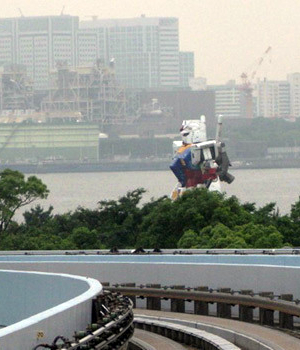Out of all the E3 presentations this week, one that didn’t really stand out was Titanfall 2. But why not? It’s giant mechs fighting other giant mechs! It’s amazing! Maybe seeing as Titanfall 2 is just a repeat of Titanfall, the trailer for Titanfall 2 didn’t really amaze audiences and gaming journos.
BUT IT’S GIANT MECHS!
All right, I’ll admit, I wasn’t impressed by it either, but for a completely different reason — a more scientific reason. When you watched Pacific Rim… it’s OK you can admit you liked that movie… didn’t you sit back and wonder why we didn’t have giant mechs in our country’s armed forces? I mean with all the money that the United States spends on its military, you’d think there could be a few million sitting around to experiment on making a mech suit for our soldiers. After all, haven’t we seen mech suits being used in many of our futuristic movies like the Matrix Reloaded and Aliens?
I’ll tell you why we don’t use mechs. They make no scientific sense. I can show you mechs that have been made in real life with modern technology, And I can give you examples of why mechs just aren’t practical for combat. Follow me, and let’s science the shit out of Titanfall 2 mechs.
The Basic Design
If you’ve seen any of the trailers or played the game of Titanfall, you know that the mechs in this game are very human in design — legs, arm, feet, and hands. In fact, if it wasn’t for the giant gaping hole in its chest, the titans could be mistaken for androids of some sort. In theory, this gives the titans the same mobility as their human pilots. In a lot of ways, it’s supposed to be a natural extension of the pilot.
As seen in the latest single-player campaign trailer for Titanfall 2, we saw that there are laws, or core programming functions, that titans have to follow to ensure the safety of the pilot first off. Clearly, those prime directives will be referenced hard in the next game, likely hearkening back to Isaac Asimov’s laws of robotics.
As we can see by the trailers, these titans are as dexterous as a human. In fact, the scene with the two titans fighting with swords was clearly motion captured– showing that they are more robot than they are tank or some other kind of military vehicle.
 Real Life Mechs
Real Life Mechs
We’ve all likely seen the 1-to-1 scale Gundam in Shizuoka, Japan. If not, you can see an awesome image of it in this article. It looks amazing and would scare the shit out of anyone who happens to be riding the tram for the first time. However, this mech is clearly not functional and far from practical.
There are actually a couple of functioning mechs in the world, but right off the bat you will notice that these two machines are not like the mechs from Titanfall, primarily, because they do not have feet. This means that they will not traverse terrain the same way that our fabled titan mechs would. The MegaBots MKII mech rises up on two legs, but the “feet” are giant treads, and the Kurata mech suit employs three legs and wheels. The biggest downfall for both of these mechs is that they both travel slower than humans. The MKII tops out at about 4 km/h and the Kurata runs at about 10 km/h. The average human can run at about 13 km/h (3.6 m/s).
Why Are Mechs So Slow?
There are two mathematical principles working against mechs. The first is the square-cube law, which states that the volume of an object will always grow faster than its surface area. The second is Newton’s second law again, which when reduced to a mathematical formula states that the force exerted on an object is equal to its mass times its acceleration. Proportionately, it takes a lot more force to move a mech three times the size of a human than it takes to move a human.
Let’s math.
To illustrate the principle we will calculate using Newtons which is equal to 1 kg•m/s². To reach our desired mass, we will assume that mass is proportional to the volume of an object. There are many other factors to consider for mass-versus-volume, but for this particular instant, we will assume they are proportional.
Obtaining the volume of an object versus its surface area is fairly simple. A cube with the volume of 1 m³ will have the surface area of 6 m². If we multiply the surface area of the cube by 2, then we are actually multiplying it by the square of 2. However, if we were to multiply the volume by 2, it would be the cube of 2.
Our real life mechs aren’t quite three times the size of the average human, but titans are at least that. So, that’s a good place to start. If the average human is 1.6 m tall and has the surface area of 1.8 m², if multiplied three times over the surface area would be 16.2 m². And, if the optimal body weight of a human is 63 kg then our 4.8 meter tall human would weigh about 1,700 kg.
Now that we have all our numbers, we can see that it takes about 226.8 N to move our average human and 6,120 N to move a proportional mech. That’s almost 27 times the amount of force to move a mech than to move a human. This can be circumvented by spreading out the force over a larger surface, but that is exactly why these mechs need treads or, in the case of Kurata, a third leg. And that’s not even counting the balancing issues.
What did you think? Science is best only when tested and retested. Did I get it right? Let me know your thoughts in the comments below.







Published: Jun 16, 2016 12:12 pm